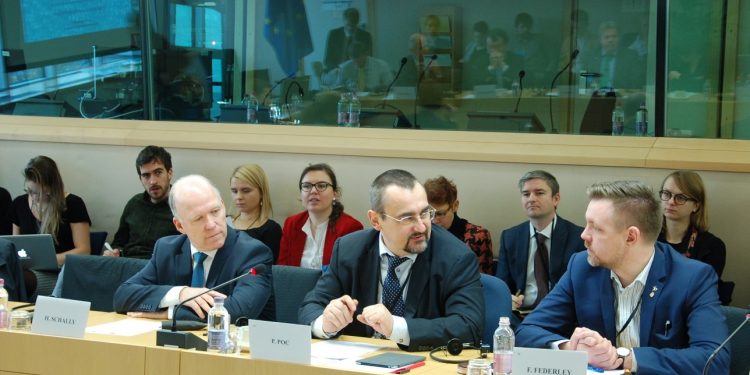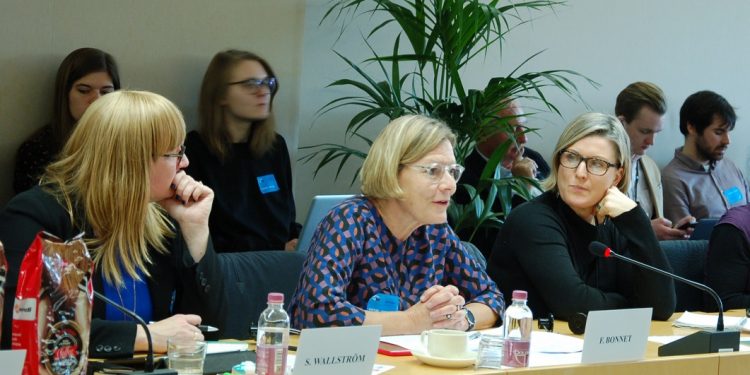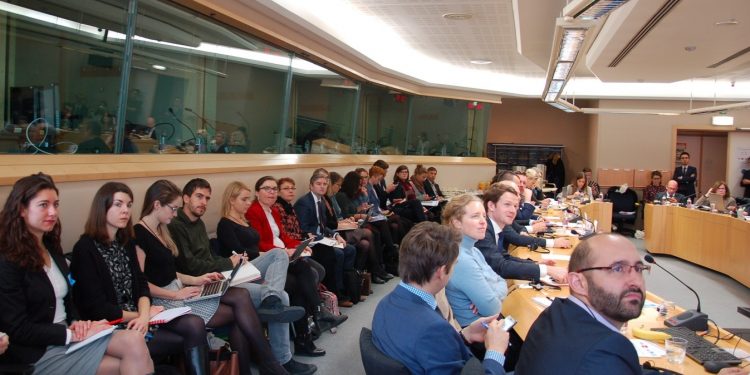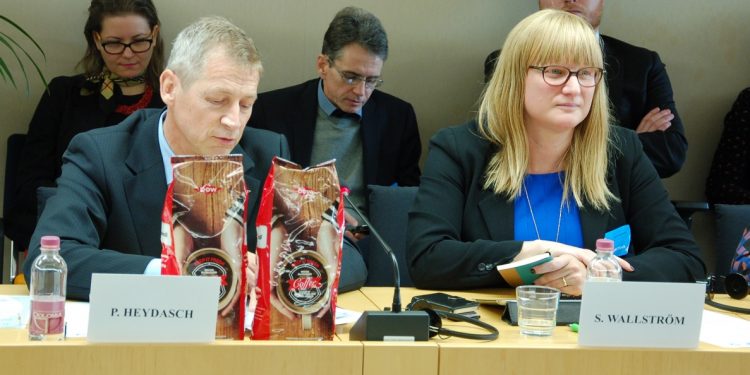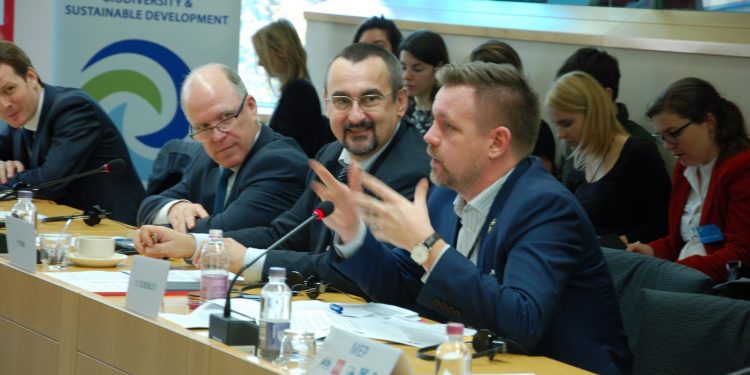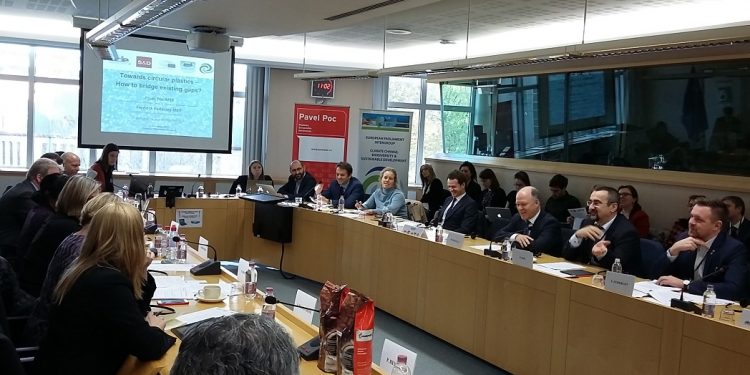Towards circular plastics – How to bridge existing gaps?
On Wednesday 22 November Pavel Poc MEP and Chair of the EP Intergroup on Climate Change, Biodiversity, and Sustainable Development hosted together with Fredrick Federley MEP and Chair of the Circular Economy and Raw Materials Working Group this event.
In the wake of the release of the European Commission’s Communication “A European Strategy for Plastics in a Circular Economy”, this conference aimed to consolidate discussions on the current challenges towards circularity of plastics and how to bridge the existing gaps. Policy-makers, industries, NGOs, and stakeholders gathered in the European Parliament to discuss the challenges and opportunities in the different phases of the plastics circle.
Pavel Poc MEP and Chair of the EP Intergroup on “Climate Change, Biodiversity, and Sustainable Development” welcomed participants by highlighting that plastics are high on the agenda as the Commission will very soon be releasing its Strategy for Plastics in a Circular Economy. It was said that plastic has specific characteristics that make it a critical component in many different applications. The plastics industry plays an important role in the EU economy generating employment and economic opportunities while at the same time it remains a challenge as less than one third of plastics is recycled generating a large amount of yearly waste. It was emphasised that increasing recycling and reuse of plastic packaging is crucial to Europe’s plastic waste management. It was also said that extended producer responsibility (EPR) has the potential to play a key role by evolving from a cost recovery approach to one that also incentivises a transition to a circular economy. It was concluded by stressing the need to go one step further in order to break any barriers that hamper the EU from achieving the necessary progress.
Françoise Bonnet, EPR Club Secretariat introduced the EPR Club, which was founded in 2012 with the support of the European Commission and brings together stakeholders from all concerned areas to further a dialogue on EU policy developments and technical implementation of EPR systems throughout Europe. The Club is a multistakeholder platform for discussion on EPR including members from public authorities, producer responsibility organisations, waste management companies, producer material federations and NGOs.
Hugo Schally, Head of Sustainable Production, Products & Consumption, DG ENV, European Commission, outlined that the transition to a circular economy is a priority for the EU and that protecting the environment and boosting competitiveness go hand in hand, which is also embedded at the international level in the Sustainable Development Goals. It was outlined that the Circular Economy Action Plan includes plastics as one of its priorities also underlining that it is linked to other priorities in a cross sectorial way. When dealing with plastics it was said that product design and material efficiency are pivotal aspects to consider. There is a lot of emphasis on product requirements but this is also linked to the implementation of the eco-design directive working plan. The Commission is working on standards on material efficiency. As part of the Circular Economy Action Plan of 2015 it has also committed to examine by 2018 options and actions for a framework on product policy, which is supportive to the transition to a circular economy. With regards to consumption it was stated that the EU must help consumers and public authorities choose sustainable and circular products and services. Further, only by providing reliable, standardised and comparable information can we enable optimisation of policy and investment decisions. The importance of waste management was raised and the need to get the EU systems up to speed also mentioning the need to conclude the ongoing co-decision procedure of the waste package. A well functioning market for secondary raw materials is also needed highlighting the importance of having a better understanding of the uses of recycled materials and providing clearer definition of the requirements that they need to meet. It was stated that the Commission is well on track implementing its plans also expressing satisfaction on the productive dialogue with stakeholders. With regards to the upcoming plastics strategy it was said that it is essential to link the communication on the interface between chemicals, waste and product policy, which is also under preparation in order to ensure that materials are safe and designed for the long term. This communication will propose options for concrete measures and the Commission will engage with stakeholders on this in 2018. It was stressed that the EU cannot continue with business as usual as the production of plastics will spiral out of control with significant resource, use, end-of-life, and waste implications. With regards to the plastics strategy the aim is to exploit the full potential of plastics reuse, recycling, and uptake of recyclates, as well as reduce the plastic leakage in the environment. It was informed that the feedstock issue is regarded as an issue for research and innovation as there is not much that public policy rules can currently do in this regard other than working on the market for secondary raw materials. The Commission has gathered additional evidence throughout the year looking closely at issues such as microplastics and marine litter, which will be tackled also in the plastics strategy. In addition, multiple targeted stakeholder consultations have been held. One important area of intervention is design to ensure durability and recyclability, which is closely linked to eco-design. The Commission also aims to work on traceability in the sense of transmitting information to enable recyclers to make the right choice and guarantee a stable supply of high quality recyclates. It was mentioned that funding is needed to identify targeted research and innovation. In addition, better implementation of existing waste legislation is needed in order to: minimise landfilling, reduce incineration, separate collection of plastics, targets for recycling and packaging, EPR – fee modulation. The need to promote the market for recycled plastics was raised, underlining the need for economic incentives to use recycled plastics. This also needs to be linked to available tools on product policy as well as to support industrial fora and platforms. The need to combat litter in the aquatic environment was reiterated underlining that the major source of this is single-use plastics. Work will also be announced regarding biodegradable plastics in order to provide harmonised criteria and raise consumer awareness. It was said that major work is ongoing on eco-design of material efficiency which will also affect the strategy. 2018 will also be the year when the Commission will decide on the follow-up of the product/organisational environmental footprint pilot. It was concluded by informing that the European Circular Economy Stakeholder Platform is now online bringing together networks of stakeholders to share best practises, initiate and moderate policy dialogues and to foster additional commitments. It was informed that the next circular economy stakeholder conference is planned for 21 February 2018. One idea that will also be discussed within this platform is whether stakeholders would be interested to provide a series of pledges or commitments that showcase how different sectors wish to go in the direction of the circular economy.
The conference proceeded with three panel debates, each tackling a different phase of the plastics circle.
Panel 1: Production Phase: How to create circular-friendly plastic products and packaging?
Carlos de Los Llanos, Scientific Director, CITEO, which is a French Producer Responsibility Organisation in charge of household packaging and graphic paper. It was outlined that the French EPR scheme is often mentioned as one of the most advanced in terms of fee modulation. France has set up different tariff fees for packaging according to their ability to be recycled or according to the difficulty that some kind of packaging produces in recycling. It was stated that if you want to modulate the fee it must reflect reality, meaning some have to pay more and others less. It is however important to justify why some have a higher fee. This must be based on facts, figures and a scientific approach as it could otherwise create concerns in terms of competition between packaging. Once the fee is justified it is essential to explain how companies can reduce their fee by e.g. putting more sustainable packaging on the market or by getting rid of packaging that is difficult to recycle. Further, it was said that modulation of the fee is only one part, underlining that companies must also work on information and training to continuously improve. Lastly, the duration of these fees was raised. It was said that companies cannot change operations in the middle of the year wishing for long term perspectives. The importance of improvement in recycling technology was also raised. It was concluded by stating that modulation of fee is a technical tool that should be designed by the packaging industry.
Peter Heydasch, Director Sustainability and Advocacy, Packaging and Specialty Plastics EMEA, DOW Chemical Company outlined that plastics have an important role to play in minimising the environmental footprint in many product categories the EU Commission identified having the highest environmental impact (EIPRO 2006). DOW collaborates with various partners such as Ocean Conservancy and the Ellen McArthur Foundation to further pursue its sustainability agenda. It was stated that research and innovation are key in delivering circular solutions. DOW recently launched a barrier adhesive, which allows non recyclable packaging designs to be replaced with recyclable structures. This was showcased also underlining that the plastics industry is contributing to resource efficiency and to plastic design changes. A complete landfill ban in Europe is pivotal to capture plastics and its value but also to prevent leakage to the environment. However, as more than 80% of marine litter originates from Asia, it was said that Commission needs to take a stronger global lead on practical improvements in global waste management. Only plastic that is collected and sorted by adequate waste management systems can be recycled. It was said that longer-term regulatory certainty is needed to support investments in waste management systems and waste recovery/recycling technologies. A good example is the new packaging law in Germany, where high recycling rates are accelerating innovations. It was concluded by reiterating the need for global action on marine litter, in a similar fashion of the phase-out chlorofluorocarbons (CFCs) in the 1987 Montreal Protocol.
Stina Wallström, Project Leader, Public Affairs, IKEA stated that the company wants to be part of the solution and not part of the problem as businesses have a great responsibility to design for sustainability. It was said that IKEA invests heavily in circularity but that the entire value chain needs to be involved as well. Support from the legislators is crucial. It was emphasised that a legal system is needed encompassing the different legal acts on e.g. chemicals, products and waste management working together to promote circularity. With regards to design it was said that producers must design for circularity. It was informed that for short lived products, such as packaging this often implies design for recycling. However, for long lived products such as furniture, designing for durability, upgrade or reuse is considered the better option. It was reiterated that it is important that legislators also support this by providing the flexibility to choose. It was said that providing the legislative framework needed will take time. However, it was said that the EU can already harmonise the requirements in EPR legislations and contractual requirements. It was said that red tape does promote circularity but rather hinders investments that could be better spent on developing new and innovative products.
The discussion among panellist and the audience highlighted the need to strike the right balance to ensure that applicable legislation is put forward for many types of industry and types of plastics without becoming so detailed that it destroys innovation. It was pointed out that it is important to draw conclusions based on real experience taking place on the ground in order to ensure that this is translated into adequate legislation. It was reiterated to involve all actors from the value chain as well as the virgin plastic producers as they are new in recycling. In addition, it is important to discuss and inform with customers and to also promote them to discuss with their customers. With regards to waste collection it was said that deposit collection should be a complementary solution. The struggles of getting consumers to take part in collection schemes was raised as a daily struggle also highlighting that many countries do not yet have the proper infrastructure for collecting all types of waste. With regards to what is needed from public policy it was highlighted that waste has value and companies need to be allowed to secure their own packaging waste material in order to ensure closed loops. The need for harmonisation was reiterated as well as market surveillance.
Panel 2: (Post-) Consumption Phase: How to set the right incentives for a circular-friendly behaviour?
Françoise Bonnet, Secretary General of ACR+, which is the Association of cities and regions for sustainable resources management, expressed the need to have the right incentives in place to push for more circular-friendly behaviour, both consumer behaviour and producer behaviour. From a public authority perspective, it was said that it is important to keep this in mind to work on consumers as well as the local industry. Public awareness was raised as an important incentive in order to provide information and ensure prevention. The promotion of reuse and durability of materials was raised in order to promote the consumer to choose the right product and the producers to put the right product on the market. The need to ensure a multistakeholder approach was emphasised as all actors must be committed and collaboration is needed to put in place the most suitable measures. EPR is an important instrument also mentioning fee modulation, however it is not enough. Green public procurement was stressed as an important incentive, which can be promoted by public authorities and help innovation. The need to impose as much as possible the separate collection of all plastics was underlined also highlighting the need to collect all plastics also calling upon the recyclers to secure the quality. It was concluded by reiterating the importance of collaboration among actors in the value chain in order to put in place the right legal and economic instruments at local, regional, and national level.
Clarissa Morawski, Managing Director, Reloop underlined that we must draw from our experiences in order to make sustainable decisions for the future. It was said that the Western part of the world has been too dependent on China, which has now banned foreign waste, putting us in a deep recycling disaster. It was said that since this announcement much of the plastic is still being put in incinerators and landfills rather than being recycled. The dependency on oil prices was also raised further aggravating the problem. It was said that education and awareness are important, however, it will not solve the problem as it is embedded in our mentality. It was called for mandatory recycled content, which can be put in place for many products. It was also said that there are various examples offered by jurisdictions throughout the world. Even though many companies are pursuing great voluntary measures it was said that it is not enough taking into account the quantity and volume of plastics produced. It was said that target setting needs to be more focused (i.e. product-specific) and measurement more meaningful, moving beyond weight-based goals. It was underlined that tools that involve money are most often the ones that successfully change the behaviour of consumers mentioning the charge on plastic bags and deposit return. It was concluded to take stock of these past learnings in order to implement policies that actually work.
Ariadna Rodrigo, Rethink Plastic Alliance outlined that for the EU to have a coordinated approach on plastics, with a sense of purpose and direction, it needs to measure the amount of plastics put on the market and to have a strategy to reduce its use. EU climate policy is based on measuring greenhouse gas emissions, setting out reduction targets and introducing policies that will ensure these targets are met. Plastics, as the fastest-growing pollutant in the world, need the same approach. At the moment, any relevant policy such as a minimum recycled content for new plastics or EPR, although good ideas, lack the sense of direction and do not amount to any concrete policy objective. Reference was also made to the Montreal Protocol, which introduced a cap and reduction targets for CFCs, reiterating that this could be done also for plastics. It was said that data on plastics is hard to come by but recent studies from the Ellen McArthur Foundation show that there is the opportunity to reduce 50% of the current plastic packaging, either by redesigning it or re-using it in an economically attractive manner. It was said that this could be used as an initial reduction target for plastic use, since it is good for the environment, economically attractive and by promoting reuse deposit return schemes are promoted, which creates jobs. It was concluded that the fee modulation for EPR schemes need to be high enough to incentivise product and packaging re-design.
The discussion among panellist and the audience highlighted that it is difficult for companies to support legislative action on recycled plastics and products as they have high internal codes that must be upheld concerning quality and safety. It was described as a chicken and egg situation. It was suggested to put the minimum content relatively low to start with in order to bring in investment and slowly increase the quality and ultimately reaching the targets. In relation it was called for more regulation at EU level on secondary raw materials.
Panel 3: Recovery Phase: How to create value out of plastic “waste”?
Philippe Diercxsens, Packaging and Environment Manager, Danone stated that if value is to be created for packaging waste it must be diverted from landfills. It was said that Danone is producing two big groups of products, bottles (PET) and yoghurt packaging made out of polystyrene. The two materials are very different when speaking about value. PET has great value and is one of the most collected materials in Europe. Polystyrene on the other hand has a poor market outlook and substitutes are currently being examined. This will however come at a cost, which will not come over night. In order to create value it is essential to create design for recycling rules. It was informed that Danone has collaborated to help set up the EU PET bottle platform, which has designed strict rules to improve recyclability of PET bottles. Fee modulation was mentioned underlining that eco-modulated fees could be applied to incentivise change by favouring companies who apply the eco rules and by penalising the companies who introduce PET bottles that hamper the recycling chain. It was concluded by calling on the EU to establish common principles for eco-modulated fees.
Helmut Schmitz, Head of Communications and Public Affairs, The Green Dot (Der Grüne Punkt), highlighted that the necessary sorting and recycling technologies are available and allow for high quality plastics recycling. The Problem is more the lack of political will which is needed to creating a level playing field and develop the market for secondary plastics. A joint approach is needed among stakeholders and legislators. It was stated that high recycling targets are needed in order to get the process started. It was informed that Germany has new national packaging legislation increasing the recycling quota from 36% to 58% by 2019. Standardisation is essential also allowing for economies of scale, also mentioning that investments for this remain an unanswered question. Another aspect raised is the development of quality standards for secondary plastics and improved authorisation of recycled plastic for food content, which would push a lot in the market as well. It was stated that a level playing field must be ensured. It was said that there are technologies available to produce high quality recyclates however demand is still low as virgin plastics are usually cheaper. Political action is needed to balance the competitive disadvantages of secondary plastics and to create incentives for their use e.g. CO2-bonus, eco-design requirements, GPP, labelling. It was concluded by reiterating the need for cooperation along the value chain, the importance of legislation and high recycling targets.
Andreas Kessler, Director Business Unit Plastics Benelux and Germany, SUEZ, emphasised the importance of dialogue and collaboration among the plastics value chain actors. Looking back on legislation in the past years it was said that it has focused a lot on EPR schemes, collection, and sorting, which are important aspects. However, it was said that less attention was given to the problems of the recyclers and that not enough discussion has taken place to help them. It was emphasised that recyclers fight on an output market, which is dominated by the virgin plastics also characterised by fluctuating prices. This also results in poor business cases for recyclers that forced them to push material to lower quality applications to avoid costly investments. If progress is to be made towards adding value to plastic waste it was said that a closed loop economy is needed where the recycled materials replace or compete with virgins. To achieve this it was said that more recyclable plastics are needed as well as investments in additional high quality recycling capacity. It was further said that brand owners need to take up this capacity and incorporate recycled plastics into their products and design in order to be recycled. It was concluded by stressing the need to stabilise the price of recyclates and improve the business cases for recyclers by implementing support measures e.g. lower VAT rates and incentives for CO2 savings.
Fredrick Federley MEP and Chair concluded the conference by highlighting that the EU must achieve responsible, recyclable and environmental friendly use of plastics as it is contained in all areas of our daily lives and put it down in a comprehensive legislative process. This process has now started as the Parliament and stakeholders eagerly await the Commission Strategy and moving forward on tackling some of the problems mentioned.




